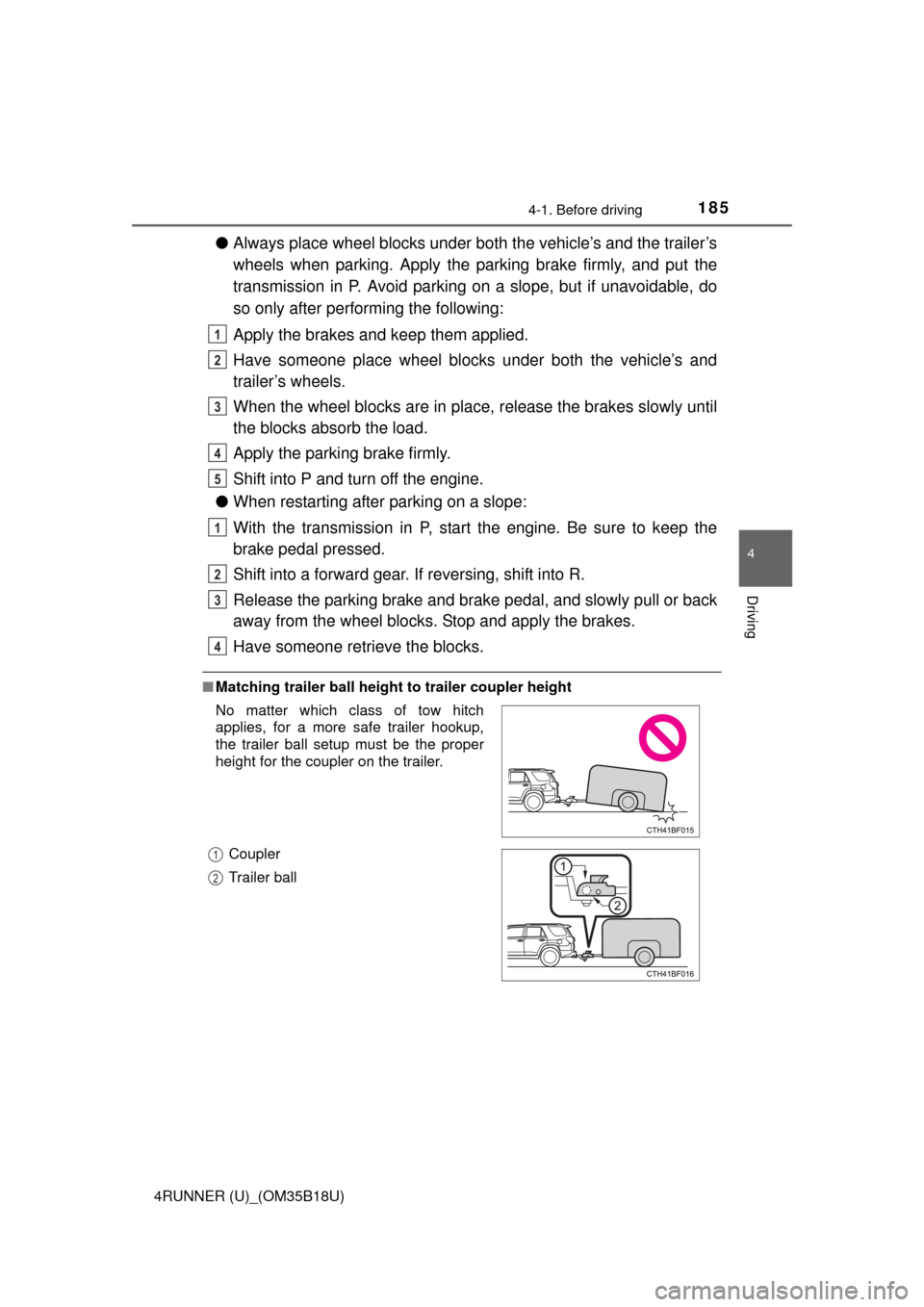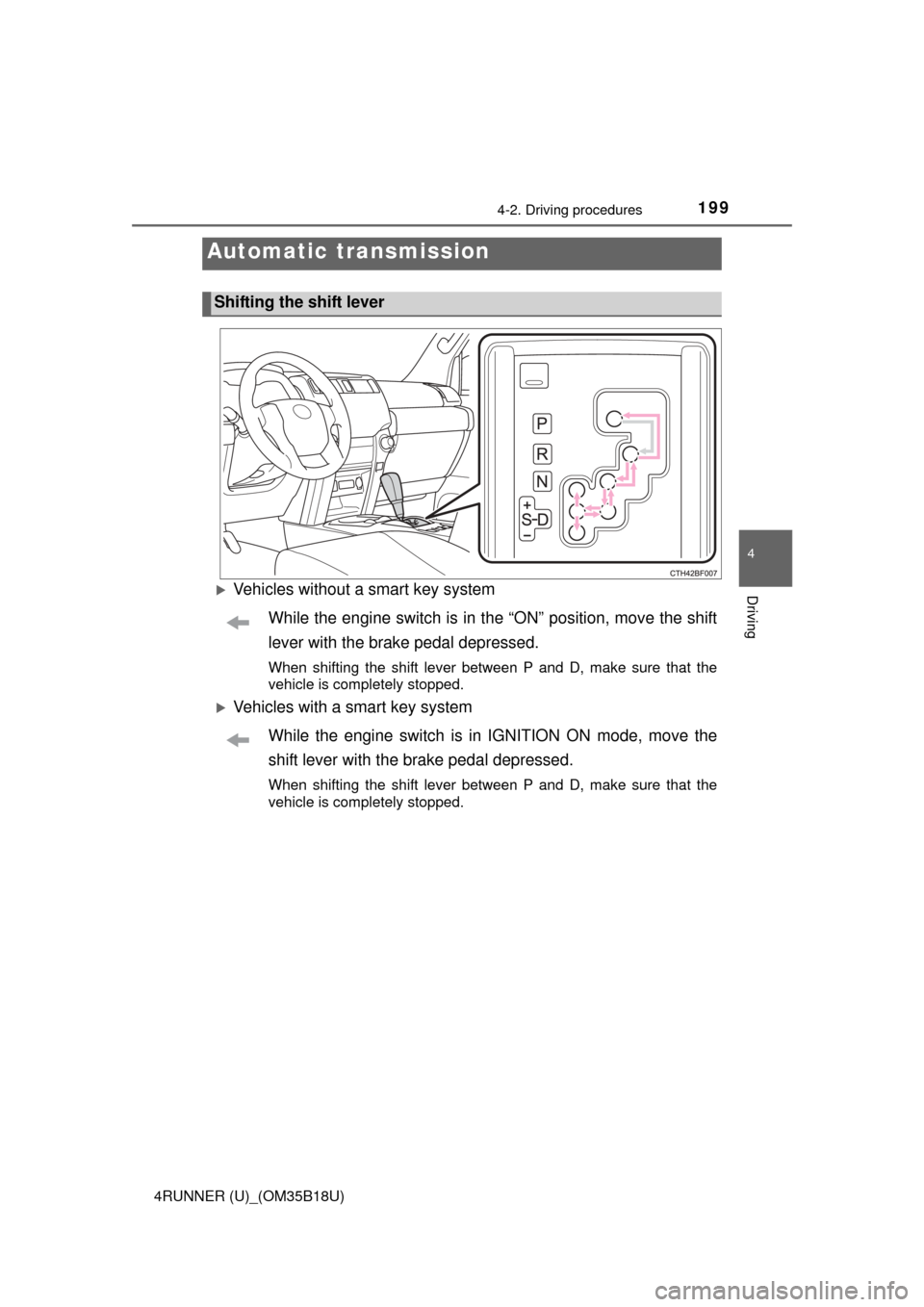2015 TOYOTA 4RUNNER Transmission
[x] Cancel search: TransmissionPage 3 of 524

3
1
8 7
6
5
4
3
2
9
4RUNNER (U)_(OM35B18U)4-1. Before driving
Driving the vehicle ............. 158
Cargo and luggage............ 168
Vehicle load limits ............. 173
Trailer towing..................... 174
Dinghy towing.................... 190
4-2. Driving procedures Engine (ignition) switch (vehicles without a
smart key system) ........... 191
Engine (ignition) switch (vehicles with a
smart key system) ........... 194
Automatic transmission ..... 199
Turn signal lever................ 202
Parking brake .................... 203
4-3. Operating the lights and wipers
Headlight switch ................ 204
Fog light switch ................. 210
Windshield wipers and washer ............................ 212
Rear window wiper and washer ............................ 215
4-4. Refueling Opening the fuel tank cap .................................. 218 4-5. Using the driving
support systems
Cruise control .................... 221
Intuitive parking assist ....... 225
Four-wheel drive system (part-time 4WD
models)............................ 231
Four-wheel drive system (full-time 4WD
models)............................ 235
Active traction control system ............................. 239
AUTO LSD system ............ 241
Rear differential lock system ............................. 243
Downhill assist control system ............................. 246
Crawl Control ..................... 249
Multi-terrain Select............. 252
Driving assist systems ....... 259
4-6. Driving tips Winter driving tips .............. 268
Off-road precautions .......... 272
4Driving
Page 157 of 524

157
Driving4
4RUNNER (U)_(OM35B18U)4-1. Before driving
Driving the vehicle ............. 158
Cargo and luggage ........... 168
Vehicle load limits ............. 173
Trailer towing..................... 174
Dinghy towing ................... 190
4-2. Driving procedures Engine (ignition) switch (vehicles without a
smart key system) ........... 191
Engine (ignition) switch (vehicles with a
smart key system) ........... 194
Automatic transmission ..... 199
Turn signal lever................ 202
Parking brake .................... 203 4-3. Operating the lights and
wipers
Headlight switch ................ 204
Fog light switch ................. 210
Windshield wipers and washer ............................ 212
Rear window wiper and washer ............................ 215
4-4. Refueling Opening the fuel tank cap .................................. 218
4-5. Using the driving support systems
Cruise control .................... 221
Intuitive parking assist....... 225
Four-wheel drive system (part-time 4WD
models) ........................... 231
Four-wheel drive system (full-time 4WD
models) ........................... 235
Active traction control system ............................ 239
AUTO LSD system............ 241
Rear differential lock system ............................ 243
Downhill assist control system ............................ 246
Crawl Control .................... 249
Multi-terrain Select ............ 252
Driving assist systems ...... 259
4-6. Driving tips Winter driving tips ............. 268
Off-road precautions ......... 272
Page 162 of 524

1624-1. Before driving
4RUNNER (U)_(OM35B18U)
CAUTION
Observe the following precautions.
Failure to do so may result in death or serious injury.
■When driving on slippery road surfaces
● Sudden braking, acceleration and steering may cause tire slippage and
reduce your ability to control the vehicle, resulting in an accident.
● Sudden acceleration, engine braking due to shifting, or changes in engine
speed could cause the vehicle to skid, resulting in an accident.
● After driving through a puddle, lightly depress the brake pedal to make
sure that the brakes are functioning properly. Wet brake pads may prevent
the brakes from functioning properly. If the brakes on only one side are wet
and not functioning properly, steering control may be affected, resulting in
an accident.
■ When shifting the shift lever
● Do not let the vehicle roll backward while the shift lever is in a driving posi-
tion, or roll forward while the shift lever is in R.
Doing so may cause the engine to stall or lead to poor brake and steering
performance, resulting in an accident or damage to the vehicle.
● Do not shift the shift lever to P while the vehicle is moving.
Doing so can damage the transmission and may result in a loss of vehicle
control.
● Do not shift the shift lever to R while the vehicle is moving forward.
Doing so can damage the transmission and may result in a loss of vehicle
control.
● Do not shift the shift lever to D while the vehicle is moving backward.
Doing so can damage the transmission and may result in a loss of vehicle
control.
● Moving the shift lever to N while the vehicle is moving will disengage the
engine from the transmission. Engine braking is not available when N is
selected.
● Be careful not to shift the shift lever with the accelerator pedal depressed.
Shifting the shift lever to a gear other than P or N may lead to unexpected
rapid acceleration of the vehicle that may cause an accident and result in
death or serious injury.
Page 184 of 524

1844-1. Before driving
4RUNNER (U)_(OM35B18U)
●Avoid jerky starts or sudden acceleration.
● Avoid jerky steering and sharp turns, and slow down before making
turn.
● Note that when making a turn, the trailer wheels will be closer than
the vehicle wheels to the inside of the turn. Compensate by making
a wider than normal turning radius.
● Slow down before making a turn, in cross winds, on wet or slippery
surfaces, etc.
Increasing vehicle speed can destabilize the trailer.
● Take care when passing other vehicles. Passing requires consider-
able distance. After passing a vehicle, do not forget the length of
your trailer, and be sure you hav e plenty of room before changing
lanes.
● To maintain engine braking effici ency and charging system perfor-
mance when using engine braking, do not put the transmission in
D.
● Instability happens more frequently when descending steep or long
downhill grades. Before descending, slow down and downshift. Do
not make sudden downshifts while descending steep or long down-
hill grades.
● Avoid holding the brake pedal down too long or applying the brakes
too frequently. This could cause th e brakes to overheat and result in
reduced braking efficiency.
● Due to the added load of the trailer, your vehicle’s engine may over-
heat on hot days (at temperatures over 85°F [30°C]) when driving
up a long or steep grade. If t he engine coolant temperature gauge
indicates overheating, immediately turn off the air conditioning (if in
use), pull your vehicle off the road and stop in a safe spot.
( P. 450)
Page 185 of 524

1854-1. Before driving
4
Driving
4RUNNER (U)_(OM35B18U)
●Always place wheel blocks under both the vehicle’s and the trailer’s
wheels when parking. Apply the pa rking brake firmly, and put the
transmission in P. Avoid parking on a slope, but if unavoidable, do
so only after performing the following:
Apply the brakes and keep them applied.
Have someone place wheel blocks under both the vehicle’s and
trailer’s wheels.
When the wheel blocks are in place, release the brakes slowly until
the blocks absorb the load.
Apply the parking brake firmly.
Shift into P and turn off the engine.
● When restarting after parking on a slope:
With the transmission in P, start the engine. Be sure to keep the
brake pedal pressed.
Shift into a forward gear. If reversing, shift into R.
Release the parking brake and brake pedal, and slowly pull or back
away from the wheel blocks. Stop and apply the brakes.
Have someone retrieve the blocks.
■ Matching trailer ball height to trailer coupler height
1
2
3
4
5
1
2
3
4
No matter which class of tow hitch
applies, for a more safe trailer hookup,
the trailer ball setup must be the proper
height for the coupler on the trailer.
Coupler
Trailer ball
1
2
Page 186 of 524

1864-1. Before driving
4RUNNER (U)_(OM35B18U)■
Before towing
Check that the following conditions are met:
●Ensure that your vehicle’s tires are properly inflated. ( P. 464)
● Trailer tires are inflated according to the trailer manufacturer’s recommen-
dation.
● All trailer lights work as required by law.
● All lights work each time you connect them.
● The trailer ball is set at the proper height for the coupler on the trailer.
● The trailer is level when it is hitched.
Do not drive if the trailer is not level, and check for improper tongue weight,
overloading, worn suspension, or other possible causes.
● The trailer cargo is securely loaded.
● The rear view mirrors conform to all applicable federal, state/provincial or
local regulations. If they do not, install rear view mirrors appropriate for tow-
ing purposes.
■ Break-in schedule
If your vehicle is new or equipped with any new power train components
(such as an engine, transmission, differ ential or wheel bearing), Toyota rec-
ommends that you do not tow a trailer until the vehicle has been driven for
over 500 miles (800 km).
After the vehicle has been driven for over 500 miles (800 km), you can start
towing. However, for the next 500 miles (800 km), drive the vehicle at a speed
of less than 45 mph (72 km/h) when towing a trailer, and avoid full throttle
acceleration.
■ Maintenance
●If you tow a trailer, your vehicle will require more frequent maintenance due
to the additional load. (See “Scheduled Maintenance Guide” or “Owner’s
Manual Supplement”.)
● Retighten the fixing bolts of the towing ball and bracket after approximately
600 miles (1000 km) of trailer towing.
■ If trailer sway occurs
One or more factors (crosswinds, passing vehicles, rough roads, etc.) can
adversely affect handling of your vehicle and trailer, causing instability.
●If trailer swaying occurs:
• Firmly grip the steering wheel. Steer straight ahead.
Do not try to control trailer swaying by turning the steering wheel.
• Begin releasing the accelerator pedal immediately but very gradually to reduce speed.
Do not increase speed. Do not apply vehicle brakes.
If you make no extreme correction with the steering or brakes, your vehicle
and trailer should stabilize. (if enabled, Trailer Sway Control can also help to
stabilize the vehicle and trailer.)
Page 199 of 524

1994-2. Driving procedures
4
Driving
4RUNNER (U)_(OM35B18U)
Vehicles without a smart key systemWhile the engine switch is in the “ON” position, move the shift
lever with the brake pedal depressed.
When shifting the shift lever between P and D, make sure that the
vehicle is completely stopped.
Vehicles with a smart key systemWhile the engine switch is in IGNITION ON mode, move the
shift lever with the brake pedal depressed.
When shifting the shift lever between P and D, make sure that the
vehicle is completely stopped.
Automatic transmission
Shifting the shift lever
Page 201 of 524

2014-2. Driving procedures
4
Driving
4RUNNER (U)_(OM35B18U)
■S mode
When the shift range is “3” or lower, holding the shift lever toward “+” sets the
shift range to “5”.
■ AI-SHIFT
AI-SHIFT automatically selects the optimal gear according to driver perfor-
mance and driving conditions.
AI-SHIFT automatically operates when the shift lever is in the D position.
(Shifting the shift lever to the S position or paddle shifting cancels the func-
tion.)
The engine speed may remain high after releasing the accelerator pedal. This
does not indicate a malfunction.
■ When driving with cruise control system
Engine braking will not occur in S mode, even when downshifting to “4”.
(P. 221)
■ If the shift lever cannot be shifted from P
P. 443
■ If the “S” indicator does not come on even after shifting the shift lever to
S
This may indicate a malfunction in the automatic transmission system. Have
the vehicle inspected by your Toyota dealer immediately.
(In this situation, the transmission will operate in the same manner as when
the shift lever is in D.)
■ Downshift restriction wa rning buzzer (S mode)
To help ensure safety and driving performance, downshifting operation may
sometimes be restricted. In some circumstances, downshifting may not be
possible even when the shift lever is operated. (A buzzer will sound twice.)
CAUTION
■ When driving on slippery road surfaces
Be careful of downshifting and sudden acceleration, as this could result in
the vehicle skidding to the side or spinning.